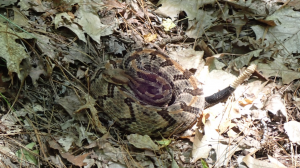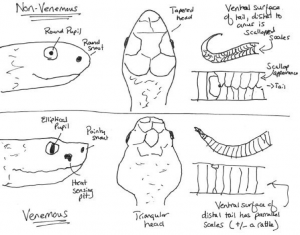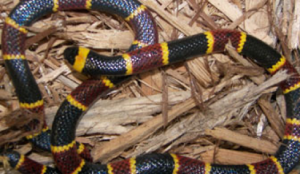Walter A. Schrading, MD, FACEP, FAWM
Director Office of UAB Wilderness Medicine

Imagine that you are backpacking with a friend in the Talladega National Forest when suddenly you hear a rustling next to the trail and a warning rattle. Your friend calls out in pain and you see a large snake slithering into the brush. Your friend has sustained two small puncture wounds to the lateral left ankle, and the area soon becomes increasingly swollen and painful. This is the snake that you saw.
What do you do? You are about 6 miles from the trail head where you started your hike and about 3 hours away from the nearest road where you could summon help. There is no cell service.
The first step is to identify that your friend has been bitten by a venomous snake. The snake shown here (and encountered by the author recently on a hike in Oak Mountain) is a Timber Rattlesnake. It is one of several venomous snakes in Alabama. Notice the word venomous. Snakes and other creatures that bite or sting are venomous, not poisonous. The Timber Rattlesnake is one of several venomous snakes known as pit vipers. In Alabama they include in addition to the Timber, the Copperhead, Eastern Diamond Back Rattlesnake, Cottonmouth/Water Moccasin, and the Pigmy Rattlesnake. There were approximately 160 exposures to these snakes reported by our Regional Poison Control Center in 2018.
Venomous pit vipers have several distinct features that differentiate them from non-venomous snakes. These snakes are characterized by their diamond or triangular shaped heads, slit or cat-like pupils, a heat sensing pit, parallel rows of scales on the ventral or undersurface of the body distal to the anus, and of course two large fangs for injecting venom! Do not try to chase the snake to kill it or photograph it in order to identify it. If you see these features, great! But don’t put yourself or others in harm’s way if the snake has bitten.
 Next, identify whether an envenomation from a pit viper has occurred. It is possible to have a “dry bite”. The snake may be immature or could have just feasted on a meal whereby it has recently emptied its venom sacks. This occurs in about 20% of bites. The characteristics of the venomous bite on the victim will be evident quickly. In addition to the fang marks, the most common signs and symptoms will be swelling and edema, pain (usually a severe burning pain), ecchymosis, fasciculations, weakness, sweating, numbness – especially of the mouth, scalp or feet – nausea and faintness. Typically, some or all of these symptoms will manifest within a half-hour and often within minutes of the envenomation. The most common locations for bites are on the extremities, typically distal extremities like hands and ankles. Approximately 35% of envenomation are mild, 25% moderate, and 10-15% severe. If swelling is evident it may progress proximally towards the trunk over hours. Envenomated victims may also begin to show signs of coagulopathy with oozing of blood at the site and more distally. Blebs which may be hemorrhagic may also develop. In severe envenomations, the victim may become hemodynamically unstable.
Next, identify whether an envenomation from a pit viper has occurred. It is possible to have a “dry bite”. The snake may be immature or could have just feasted on a meal whereby it has recently emptied its venom sacks. This occurs in about 20% of bites. The characteristics of the venomous bite on the victim will be evident quickly. In addition to the fang marks, the most common signs and symptoms will be swelling and edema, pain (usually a severe burning pain), ecchymosis, fasciculations, weakness, sweating, numbness – especially of the mouth, scalp or feet – nausea and faintness. Typically, some or all of these symptoms will manifest within a half-hour and often within minutes of the envenomation. The most common locations for bites are on the extremities, typically distal extremities like hands and ankles. Approximately 35% of envenomation are mild, 25% moderate, and 10-15% severe. If swelling is evident it may progress proximally towards the trunk over hours. Envenomated victims may also begin to show signs of coagulopathy with oozing of blood at the site and more distally. Blebs which may be hemorrhagic may also develop. In severe envenomations, the victim may become hemodynamically unstable.
Now back to our scenario. You have identified the snake as a venomous Timber Rattlesnake and your friend is showing clinical signs of envenomation. Now what should you do?
Pull out your handy pocket knife and make incisions? Suck on the wound? Apply a tourniquet? The answer to all these remedies is a resounding NO. None of these purported interventions work and in fact may make thing worse by increasing the risk of bleeding, introducing infection, and cutting off distal circulation.
When not in an austere or remote location the recommended first aid is:
- to remove rings and constrictive clothes (remember the swelling that is about to occur)
- to relatively immobilize the extremity and keep padded at heart level
- keep the victim warm and calm
- keep the victim hydrated
- No cutting
- No ice
- No NSAIDs
- call 911 and local poison control
- transport the patient to an emergency department ASAP.
 This is because, the only effective treatment for this envenomation is to give crotalidae polyvalent immune Fab as an antidote, and this is usually only available at a hospital.
This is because, the only effective treatment for this envenomation is to give crotalidae polyvalent immune Fab as an antidote, and this is usually only available at a hospital.
Do not give NSAIDs as this could complicate coagulopathy. Do not apply ice as this can worsen tissue damage. The poison control center number is 1-800-222-1222. It will help to calm the patient knowing that deaths from pit vipers are extremely rare. There are approximately 7-8000 venomous bites per year in the US, but only 6 or fewer deaths.
Your scenario has you without cell phone service and at least a three-hour hike away from the nearest road. Now what? The recommended treatment is the same, however, the only way to immobilize the ankle would be to create a stretcher and carry your friend to where transport can be arranged. If you have never tried to carry someone on a stretcher, be advised that this is extremely tiring to rescuers, time-consuming, and requires at least 6 people. So, this option doesn’t seem feasible. Keep in mind that there is no wilderness treatment for this condition, so the only answer is to get to help as quickly as possible. If this means, that your friend walks for three hours on the bitten extremity, then that is the best way to get to help and to an emergency department as quickly as possible.
Despite some pain, your friend can start walking to the nearest trailhead. Luckily after about an hour you come across some people riding on 4-wheelers and they have cell phone access. They can call 911 to have an ambulance meet you at the nearest road intersection and volunteer to transport your friend there. Your friend is seen in the ED and antivenom is given. After several days in the hospital with only mild coagulopathy/ your friend is safely discharged home.
As with most conditions, the best treatment is to avoid exposure. For snakes –
- Do not try to handle any snake
- Stay away from tall grass and piles of leaves when possible
- Avoid climbing on rocks or piles of wood where snakes may be hiding
- Be aware that snakes tend to be active at night and in warmer weather
- Wear boots and long pants when working or hiking outdoors
- Wear leather gloves when handling brush or debris
- Be aware of your environment
 * This guide will help identify pit vipers, however, in Alabama there is another venomous snake which is not a pit viper. It is the Eastern Coral Snake which has a different type of venom. This snake has the appearance of a non-venomous snake, however, its distinctive red on yellow and black banding pattern which makes it quite distinctive.
* This guide will help identify pit vipers, however, in Alabama there is another venomous snake which is not a pit viper. It is the Eastern Coral Snake which has a different type of venom. This snake has the appearance of a non-venomous snake, however, its distinctive red on yellow and black banding pattern which makes it quite distinctive.
